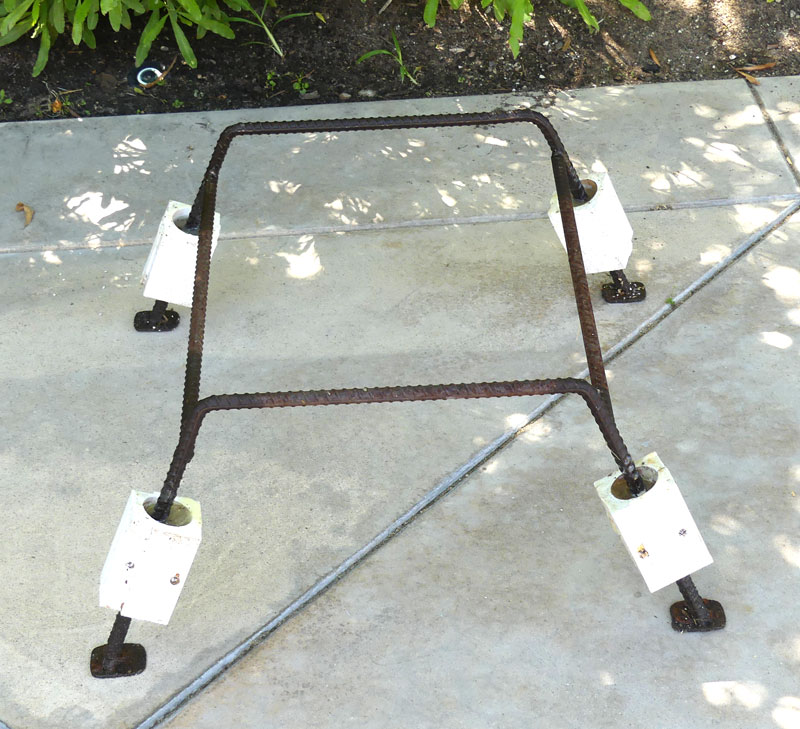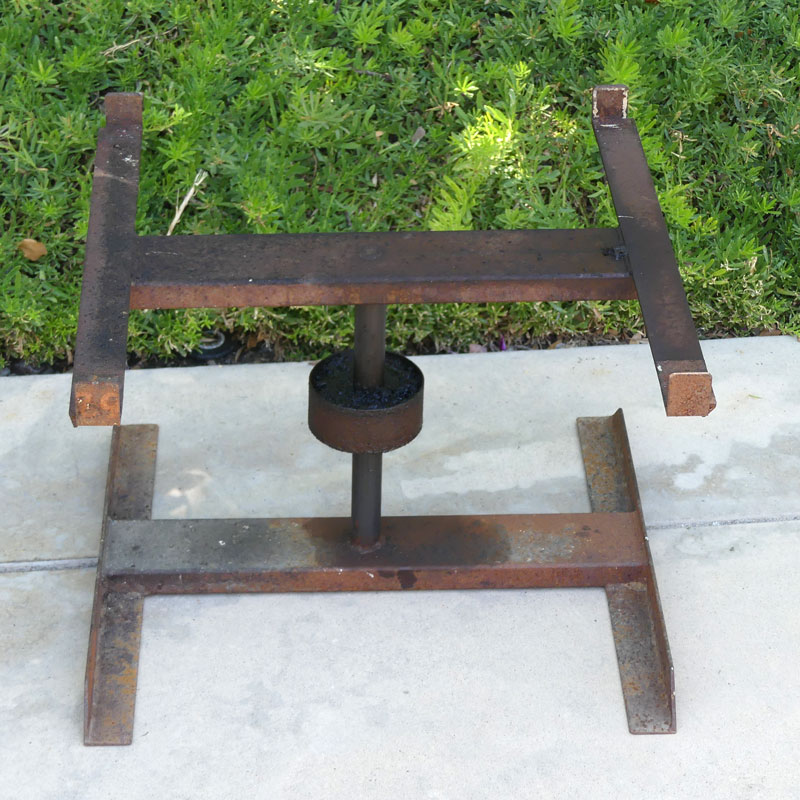
SoCal Beekeeping
Ants and Hive Stands
8/23/2017
Michael Henderson
Today, I want to talk about ants and hive stands. Ants can do some real damage to bees, especially the Argentine ants that we have in SoCal. People tell me that if the hive is strong, it can deal with ants. Maybe that's true, but for most of us, we have to take the bees through a growth stage before they're a really strong hive - and the ants can really cause problems.
Over the years I've tried many things to keep ants out of the hives.:
Put a container under each leg and fill the container with water. This works but there's some drawbacks. A lot of stuff falls into the containers - dust and leaves mostly - and eventually the water gets green with algae. Bees, also, drown in the containers because bees need water and the bees try to get water from the containers. The water can completely evaporate unless you monitor it regularly. If enough leaves fall into one of the containers, it can create a "bridge" that the ants can use to get across the water. They find those bridges pretty quickly, it seems. I don't have any pictures because I gave up on this approach long ago.
Put a container under each leg and fill the container with oil. Oil, either motor oil or vegetable oil, works similar to water but doesn't evaporate. It has the same problem with leaf bridges as water. Bees seem to think the oil is water and they drown in the oil. And if you have a hard rain, the container can fill with water, displacing the oil which flows over the top of the container.
Another beekeeper suggested putting a pie plate under each leg with a piece of carpet in the pie plate. Soak the carpet with motor oil. I haven't tried this approach so I can't give any advice about it.
Vaseline on each leg of the stand. Just rubbing Vaseline on the legs would probably not last a long time so I made some "containers" for the Vaseline for each leg of the hive stand. The wooden blocks are in two parts, and drilled with a hole the size of the leg. When installed, I put silicone caulk between the two pieces of wood to keep them from leaking. These actually worked pretty well. They're susceptible to leaf bridges but that's about it. I haven't noticed any bees dying in the Vaseline.
The Vaseline melts in the sun and becomes liquid so in the heat it works very well. In cool weather I'm concerned that ants might be able to walk across the firm Vaseline. Rain doesn't seem to affect it because the Vaseline gets hard in the cool rain so water can't get under it.

This is what a hive looks like sitting on this stand.

A special hive stand designed to keep out ants. This is what I use now and it works best. I didn't invent this but got the stands from Guerilla Beekeepers. It's a fabricated stand by a metalworker. The single center post has a cup which is filled with oil. The cup is sheltered by the hive so leaves do not fall into the cup and create bridges for the ants. And because the cup is sheltered, rain does not get into the cup and displace the oil. I have one hive that has been on a stand like this for at least five years and I've never refilled the cup with oil. And no ants.
Bees do go to the cup, thinking it's water, and drown. I'll try putting gravel in the cup next time.

Here's what it looks like with a hive body on the stand.

If you have one of these stands fabricated by a local metalworker, make sure it's strong. The center rod is solid and the top and bottom cross bars are rectangular tubes. The outside pieces are angle iron. Make sure the parts are hefty enough, especially the bottom, because the hive will sit there for years and metal rusts, especially if the bottom gets wet every time your sprinklers run. And make sure the welds are well done to hold everything together.
It probably won't be cheap but it's a lifetime product if made well and you'll never have ant problems.
+++++++++++++++++++++++++++++++++++++++
[Update 1/11/2018] I built a hive stand. I don't have a lot of experience welding so my stand looks a bit crude.

The stand is made from 1" by 1/8" angle iron, a 2" by 1/8" C-channel (the 1/8" thickness is too thin - go for something thicker), and a 1" square by 1/16" tube that supports the hive. The oil cup is made from heavy galvanized sheet and is about 3 1/2" square. That's a bit big and I'd make it smaller next time. Most of the pieces are cut to 18", and the square tube is about 12" high. Note that I rolled up the ends of the angle iron on the top to give a support area about 16 1/2" wide. A 10 frame hive is 16 1/4" wide. I cut the metal with a Sawzall type tool with a metal cutting blade.
My welding outfit is small so I brazed things together rather than welding them.

A small outfit like this will not put out enough heat to even braze but I used a MAPP torch simultaneously with the welding torch and was able to get the pieces hot enough to braze. I used the MAPP torch on the back of what I was brazing to get the metal red hot and brazed with the oxy/acetylene torch.

I'm impressed with these MAPP torches - they put out a lot of heat and a bottle lasts a long time.
Perhaps my biggest problem was to make the oil container. I used a heavy piece of galvanized sheet and hammered it to shape on a piece of wood. I probably made it too big but it's acceptable.
After I brazed everything together, I felt that the stand was not solid enough so I brazed two pieces of angle iron to the C-channel that supports the upright square tube. That made it a lot more solid.
I bought all the steel at Home Depot, which is expensive for small pieces like this, and the total cost for the metal was $52.37 (updated to reflect the additional reinforcement discussed below). Not cheap, but this type of stand really works to keep ants out of the hive, and the stand should last a lifetime.
+++++++++++++++++++++++++++++++
[Update 1/18/2018] I painted the hive stand to help slow down the rusting. I'm not much of a painter but I slapped two coats of primer on it and then two coats of exterior latex.

++++++++++++++++++++++++++++++++++++
[Update 1/19/2018] I had to add some reinforcement at the top, same as I did on the bottom. It was just too wobbly without it. The problem is the C-channel. It's just not stiff enough at 1/8" thickness. It needs something thicker and stiffer. Everything else, including the square tubing, seems to be good. With the reinforcement the C-channel is okay but thicker and stiffer would be better.
You can see in the next picture how I added a piece of angle iron on each side of the C-channel, same as the bottom. Now, I need to repaint this area.
